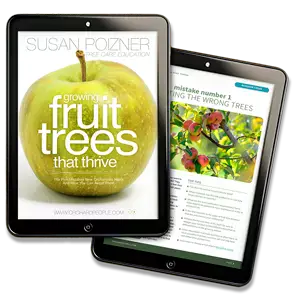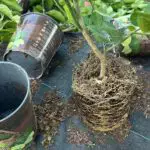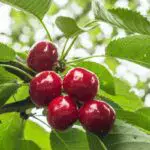How do you choose fruit trees that will work for your landscape? This article and video show you the tips Read more
How to Make Apple Cider
In this article, OrchardPeople.com’s Susan Poizner interviews Steven Biggs, Author of Grow Figs Where You Think You Can’t and other gardening books about how to make apple cider.

For garden writer Steve Biggs, Author of Grow Figs Where You Think You Can’t and other fantastic gardening books, getting family and friends together to make apple cider is an annual event. So in this interview, I pressed Steve (pun intended) to share his cider-making tips and tricks with me. And here's a spoiler alert for you: The equipment isn't always cheap and the type of apples you use to make apple cider does matter!
how to make apple cider pressing a family tradition
Steve, did you make apple cider with your family when you were growing up?
My aunt and uncle used to press cider every year and they shared it with our family. Then as an adult, their son Scott took over the tradition. One Thanksgiving, my cousin Scott invited us to make apple cider with their family. I thought it was a great way to spend time together.
I liked the tradition so much that I got a cider press once I had children. We make apple cider every year. Now my children have started their own tradition too: they invite friends over every fall to make cider.
It’s easy to get confused. What type of cider do you actually make? For some people cider means an alcoholic beverage. But for others it means “apple juice.”
“Cider” is a word with a bit of an identity crisis. When I tell some people that I make cider, they say, “Oh, you mean juice?” If you offer cider to some people and they expect sweet, fresh-pressed juice (a.k.a. sweet cider). But if you offer cider to other people, they expect an alcoholic drink (a.k.a. hard cider). You can make both at home. In fact, the first will turn into the latter without too much help.
sourcing the right apples for cider making

Where do you get your apples from?
I avoid getting apples for cider-making at a supermarket. It will cost you an arm and a leg. Instead, I head to an orchard or roadside farm stand and buy apples that are misshapen, blemished, or smaller or larger than grocery stores want. Here in Ontario those apples are often called “C” (sometimes called “cee”) grade apples.
I grow a lot of apple trees. I always wondered if you can you use windfall apples, those apples that fall off the tree onto the ground, when you make apple cider. Or is that not a good idea?
Windfall apples are collected from the ground. Depending where you live, you might also hear them called “drops” and “grounders.”
There is a long tradition of using windfall apples to make apple cider. There is also a long list of provincial, state, and municipal food-safety agencies that recommend against using windfall apples to make cider. That’s because windfall apples are more likely to have come into contact with E. coli bacteria (from livestock manures, or deer and or rodent feces.)
Here in Ontario I often find windfall apples labelled as “deer” apples…and in discussions with many farm-market operators have rarely found one willing to comment on making cider with them. It’s verboten. Here is a link for more information on windfall apples, safety and pasteurizing.

can you use imperfect apples when you make apple cider?
When you grow apples at home, they don’t always look great. Some might be spotty or diseased. Others may be infested with pests. You can’t use those to make apple cider, can you?
Sometimes apples we grow at home are a bit uglier than commercially produced apples because we don’t spray the heck out of them. That’s OK. You don’t need blemish-fee apples for cider. Scab, cat-facing from codling moth, bird pecks…they don’t matter.
What you do want to avoid is apples with large rotten areas, because these can give an “off” flavour to your cider.
In terms of pest damage, the question is really “What is your gross tolerance?” In my area, codling moth is a major insect pest. By cidering time, the larvae have left the apples. In some cases, there is only some surface damage. In others, insect frass (poop) and tunnelling are in evidence.
Fruit Trees
That Thrive

I have a paring knife in hand as I get my apples ready for making cider. If one of my apples has a small rotten area, I cut it out and use the rest of the apple, as long as it looks as if the flesh is firm and not rotten. If in doubt, I do a taste test.
If the entire apple is overly soft or rotten, I discard it. If it’s really cat-faced and I suspect a big wad of frass inside, I cut it open to have a look.
If this grosses you out, just buy C-grade apples without insect damage. I do think I have permanently turned off one of my kids from cider by using apples with tunnelling in them. The other two are fine with it.

Each year, in the Ben Nobleman Park Community Orchard, we thin the apples on our tree to improve the quality of the apples that remain on the tree. Then we throw those baby apples away. Is it possible to use those small, unripe apples if I want to make apple cider?
If your apple-management includes thinning out some of the unripe apples on your tree, make them into a sour cider. Use it instead of lemon juice or verjus.
best apple varieties for home made apple cider
When you are making cider, does it matter which apple varieties you choose?
Ciders, sweet and hard, are often made from blends of different varieties of apples. The blend varies as harvest progresses through different apple varieties. Some varieties are sweet, some are tart, some are aromatic—and some are astringent.
Some varieties are juicier than others are. ‘Macintosh,’ for example, is very juicy, while ‘Russet’ is dry and mealy. I usually have a fair bit of Macintosh in my cider because it is widely grown and available in my area.
Remember that apple variety availability varies from early to late fall. So, too, will ripeness of your apples. Cider pressed in late fall is often sweeter, as the apples are riper.
One year I saw a couple of pecks of crab apples for sale at a farm stand, so I mixed them in with apples I was pressing for hard cider. Crab apples often have lots of tannins, which can be a nice addition to a hard cider. (Tannins give the dry-in-the-mouth feel that comes with many red wines.)
Another year I called a local specialty orchard that grew many bitter and astringent cider varieties, and the orchardist made me a hard-cider blend of apples.
how to make apple cider: tools and equipment

Ok, let’s get into the nitty gritty. How do you prepare when you’re going to make apple cider?
When you are ready to get started, wash the apples with clean tap water to remove debris. I have a large outdoor sink that I use for the purpose. I also wash my press and other equipment with hot soapy water before and after use.

What cider making tools do you use?
Here’s what I have:
- A station to wash apples.
- A grinder (also sometimes called “scratter”) to grind the apples before pressing them.
- A press, which simply applies pressure to the ground up apples to squeeze out the cider.
- Something to catch the juice coming from the press.
Often you’ll buy a cider press unit that includes a grinder, a press, and the catch basin all in one unit.
So I guess the first step is to grind up the apples with your grinder?
Yes. My press had a grinder attached. When you turn the crank, a metal-studded wooden cylinder grinds the apples. Then the apple bits fall into a slatted tub in the same unit.

Next, I use a different handle which operates the screw press and I press the apple fiber (those ground up apples are called “pomace”). Apple juice runs down the tub into a tray and pours out of a hole into our cups.

You can make apple cider successfully using just one unit. But I also have a second press. This is useful because I don’t have to wait for the juice to drip out of the pomace before removing the pomace so that I can grind up a new bunch of apples. I got this second press from a friend when he upgraded his winemaking setup—and it has sped up the process.

How much cider you get will depend on the apple variety and the ripeness of the apples. Some sources talk of an apple giving about one quarter of its volume in cider. Don’t count on it—it varies a lot.
I noticed that your cider grinder and press is motorized. There’s hardly any work involved at all. Is grinding and pressing apples manually really hard work?
Hand cranking isn’t hard, but it is work. So, if you’re processing 5 or 10 bushels it’s nice to have a motorized press.
But we often don’t use the motor. If my kids are having a cider pressing party, they love to work the press.
Originally, we didn’t plan to add the motor. The instructions said you could add a motor but I didn’t bother. Then a friend offered to help me set up the motor. We used an old furnace motor and it’s nice to have the option of using it if we are pressing a lot of apples.
Hand cranking isn’t hard, but it is work. So, if you’re processing 5 or 10 bushels it’s nice to have a motorized press.

What do you do with the pomace once you’ve finished pressing the cider. Can it be used for anything?
The pomace can be very acidic. You can put it into the compost but don’t put it directly on your garden. First of all, you’ll get little apple trees sprouting from the seeds.
But also, it can ruin your plants. One year I put the pomace on my hosta patch. None of them came up the following year. Later on, I learned that it can change soil pH.
So, I’d say adding it to your compost is a much better option!
Where would you suggest people order their cider making equipment from?
Being a city boy with no country-living stores in the hood, I ordered my cider press online.
If you intend to buy equipment, remember that couriers often use extortionary practices to charge exorbitant brokerage fees on unsuspecting cross-border shoppers. I made the mistake of buying from a supplier in the USA…but by the time I paid the extortion to the courier, any savings were gone.
Be warned, the really good quality presses are not cheap. But they give better family- and community-building value than many expensive electronic gadgets do. Cider press or large-screen TV...which will stick out in your mind years later?
Here are two online stories that carry the premium cider presses.
- Canada: Berry Hill Ltd
- USA: Happy Valley Ranch
There are also a lot of cider presses available on Amazon and their prices are more reasonable. So, they may be worth a try.
It is also possible to make your own cider press. You can find resources online for that.
You make a lot of cider, how do you store it?
We guzzle the first few glasses of cider as it streams from the press. Then, after we fill a few jugs for immediate use, we switch to freezer-safe containers so we can store cider to enjoy later in the year.

One thing to remember is that you need to refrigerate fresh cider immediately. It will last 1 to 2 weeks in the fridge before it begins to ferment. For freezing, milk cartons and plastic juice bottles work well. Don’t fill containers to the top because cider expands as it freezes, and you’ll end up with a bunch of little cider volcanoes in your freezer.
Have you ever made hard cider?
After my neighbour Dave helped me install the motor on my grinder, we tackled making (and drinking) hard cider together. Fermenting carboys of cider fill the basement with a delicious smell.
We’ve tried the all-natural approach, letting naturally occurring yeasts on the apples drive the fermentation. The result tasted a bit like … socks. Champagne yeast gives us better results. Batches not fit for drinking are useful in the kitchen (cider-baked beans!)
In Episode 13 of the Urban Forestry Radio Show, I interviewed Ben Watson, author of Cider Hard and Sweet: History, Traditions, and Making Your Own and he explained how to make hard cider. I haven’t tried it yet though. My first step, one day, will be to make apple cider myself! Or…to help you and your family during one of your next cider making events. Thanks for chatting with me about making apple cider Steve!
Thanks Susan!
This page includes affiliate links. Orchard People may receive a small commission if you make a purchase. The funds will help support the creation of free resources including our blog, YouTube channel and podcast.
Fruit Trees
That Thrive


Susan Poizner
Learn more about Susan on the about us page.



